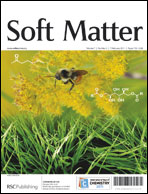Time-resolved anisotropy measurements (TRAMS) have provided invaluable information concerning the molecular interactions responsible for cononsolvency in the poly(N-isopropylacrylamide), PNIPAM, H2O, and methanol ternary system. TRAMS have successfully monitored the intramolecular segmental dynamics of an acenaphthylene labelled sample, ACE–PNIPAM, revealing details about the conformation adopted by the polymer constituent as a function of both alcohol composition and temperature of the system. In pure aqueous solution, ACE–PNIPAM undergoes a conformational transition from an expanded solvent swollen structure to a compact globule at the lower critical solution temperature (LCST). With increasing alcohol content up to 55% v/v of methanol there is both a reduction in the magnitude and an onset temperature of the LCST of ACE–PNIPAM. From 57.5–65% v/v methanol, ACE–PNIPAM forms an extended solvent swollen structure: observation of an LCST at higher polymer concentrations (e.g., 0.1 wt%) is a consequence of intermolecular aggregation between expanded chains.

You have access to this article
 Please wait while we load your content...
Something went wrong. Try again?
Please wait while we load your content...
Something went wrong. Try again?


 Please wait while we load your content...
Please wait while we load your content...